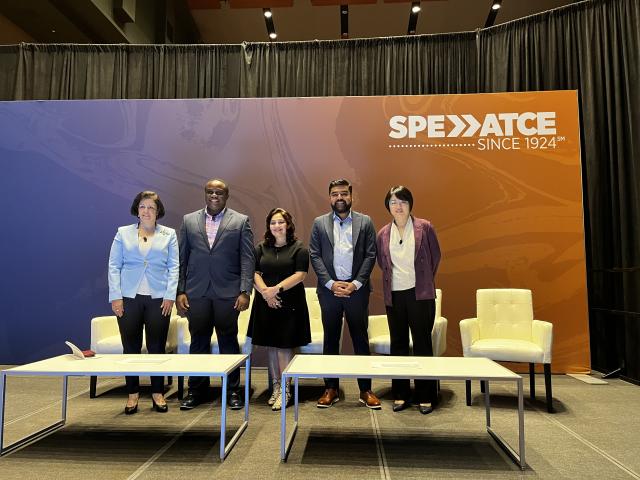
Moderator Sushma Bhan of Ikon Science with panelists Chijioke Ibeh of Chevron Nigeria Ltd., Aarti Dange of Emerson, Pushpesh Sharma of Aspentech and Yuxing Ben of Occidental Petroleum. (Source: Hart Energy)
SAN ANTONIO – What is measured can be improved, at least according to the oil and gas industry.
This mindset has led to an exponential increase in data available for analysis and decision making, and if adopted, enhances production and digitally transforms autonomous operations, panelists said during a session on data science and engineering analytics at SPE’s Annual Technical Conference and Exhibition on Oct. 17.
“Production enhancement is driven by the quality of your surveillance and the data analysis that takes place,” Chijioke Ibeh, petroleum engineering mentor for Chevron Nigeria Ltd., said.
The volume of available data has increased exponentially thanks to technology advances enabling real-time data, Aarti Dange, customer experience leader for Emerson Automation Solutions, said. And those same technology advances can help digital oilfield projects be more successful before the proliferation of real-time data, she said. Achieving advanced analytics requires real-time measurement devices that provide seamless and accurate data, she said.
“On top of that you have the orchestration, which is aggregating the data, contextualizing the data beyond that. You need to incorporate the business drivers and ensure that the right information is sent to the right people. So that's the next part, and then comes analytics,” she said.
Next step: adoption
It’s also important that people actually adopt these technologies, Dange said.
“Understanding what digital transformation actually means and adopting those skills will ensure that we have a successful journey,” she said.
Pushpesh Sharma, senior product manager at Aspentech, said sensing is critical to collect data that can be used to plan improvements for operations.
“Data science will help us put together better data collection, which will help us do better data analytics later on,” he said.
Yuxing Ben, analytics engineer at Occidental Petroleum, called for collaboration between data scientists and domain experts for their necessary knowledge and skills. An iterative collaborative approach makes it possible to create trustworthy models, she said.
As new capabilities and tools enter the workflow, Ibeh said, it is important for workers in the industry to adopt a growth mindset, rather than sticking to a “we’re used to building this way” approach.
“There needs to be that openness to change and adopting data science methods, new ways of looking at conventional problems, looking at how can we become more efficient?” he said.
People already stretched for time completing day-to-day tasks will have to take the time to learn the new technology, he acknowledged. It’s a commitment to acquiring and applying new skills for benefits in the long run, he said.
“How do I make myself more digitally fluent? Develop programs—there are programs out there and some companies already have development programs as well,” Ibeh said. “Take advantage of those. Create the time, just see how much you can because five years, 10 years, 20 years from now we'll be looking back and saying, ‘Did we really used to work like that?’”
Sharma encouraged people who want to upskill their data science capabilities to start working on it right away, rather than worrying about which tool they should learn.
“If you're looking for a perfect tool, it's not going to happen. They keep changing the tools every day pretty much right now. So just start with whatever tool you have and start using the data in reality,” he said.
Recommended Reading
ConocoPhillips Nears $1.3B Anadarko Sale to Flywheel, Stone Ridge
2025-07-23 - ConocoPhillips is in talks to sell Marathon Oil’s Oklahoma assets to Stone Ridge Energy for around $1.3 billion, multiple sources said.
ConocoPhillips Agrees to Sell Anadarko Basin Assets for $1.3B
2025-08-07 - Update: ConocoPhillips agreed to sell Marathon Oil’s Anadarko Basin assets to Oklahoma City-based private E&P Flywheel Energy for $1.3 billion. Flywheel is backed by investor Stone Ridge Energy.
Mach Dives into Permian, San Juan with $1.3B M&A
2025-07-10 - Midcontinent-focused Mach Natural Resources is expanding into the Permian and San Juan basins, doubling its production and adding greater natural gas exposure.
Coterra, Civitas Win Big in Record New Mexico State Lease Sale
2025-07-17 - Premium, undrilled inventory in the core of the Delaware Basin was gobbled up in New Mexico’s record-setting state lease sale. Coterra, Civitas and a resurgent Avant Natural Resources were among the winning bidders.
Exclusive: Chord Marketing Non-Op Gas Assets in Marcellus Core
2025-07-24 - Chord Energy is gauging market interest for non-operated gas assets in the Marcellus Shale’s core, sources told Hart Energy. Experts say it’s attractive Marcellus dry gas inventory under a premier Appalachian operator.
Comments
Add new comment
This conversation is moderated according to Hart Energy community rules. Please read the rules before joining the discussion. If you’re experiencing any technical problems, please contact our customer care team.






